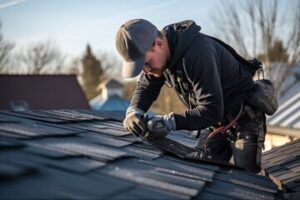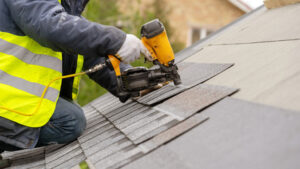A quality roof not only adds to your home’s value but protects you and your loved ones from the elements. Roofing is not a DIY project and should only be performed by a certified roofing contractor.

Before you hire a contractor, check for experience, insurance and licensing. Review their reputation and read real customer testimonials. Contact Ellingon Roofing LLC for professional expertise.
When a new roof is installed, it takes a lot of work and preparation. Whether you hire roofing professionals or do it yourself, the process is complex and demands attention to detail. Fortunately, there are steps you can take to prepare your home and minimize disruption during the project.
The first step is to thoroughly inspect the existing roof deck. If the roof deck is damaged, it needs to be repaired or replaced before any new roofing material can be installed. This will ensure that the new roof is structurally sound and provides adequate protection for your home.
Next, make sure to move any furniture or movable items from the work area. This will protect them from debris and dust and also prevent damage from accidental contact. Children and pets should also be kept away from the work area. They may be curious about the noise and activity, but they can also get injured by sharp objects like hammers and nails. It is best to have them stay with family or friends while the roofing project is underway.
You should also clear the outdoor areas of toys and patio furniture. Roofing professionals will need to walk all around your home to access the roof, so you don’t want them tripping on kids’ toys or accidentally stepping on your furniture. It’s a good idea to mark or protect any delicate plants in your yard, too. You may even want to consider putting up netting or a tarp over koi ponds and other water features.
Finally, you should tarp or cover any outdoor equipment in the shed and garage. Leaving them out in the open can lead to loss or damage from rain, dirt and falling shingles. It’s a good idea to cover any valuable items in the attic spaces, too. The installation process will cause vibrations that could dislodge or damage them.
You should also tarp the driveway and any vehicles that are left outside. Leaving them out in the open can be dangerous for everyone involved, and it’s also not good for your driveway or lawn.
Materials
When you install a new roof, you have many materials from which to choose. The choice of material not only affects how much your home will cost to re-roof, but it also affects the style and look of your house. The roofing materials you select communicate the style of your home to passersby, and they can add value to it as well.
A popular option for residential homes is asphalt shingles. These shingles are available in a wide variety of colors and styles that can complement any house. They are also affordable and easy to install. They are also weather-resistant and come with a manufacturer warranty that can last for up to 25 years.
Wood shingles and shakes are another popular roofing material. They add a natural touch to any home, but they’re not as durable as other types of roofing. They are often used on Cape Cod-style homes. Shakes are thicker wedges of wood that are shaped by hand, while shingles are thin slices of wood that are precision sawn.
Metal roofs are often used on commercial buildings, but they can also be installed on residential homes. They have a unique look and are very sturdy. Metal roofs are non-combustible and energy efficient. They can be made of a variety of alloys, including aluminum, steel and zinc.
If you’re interested in green technology, a solar-powered roofing system is a great option. These roofs require a special framing system, and they must be installed by a qualified contractor. They’re an expensive investment, but they can save you money on electricity bills and add to the resale value of your home.
One of the best things about re-roofing is that you’ll get a new manufacturer warranty. This can save you a lot of money on repairs and maintenance down the road. In addition, a new roof will help keep moisture and other harmful substances from seeping into your home.
While installing a new roof, it’s important to use the proper safety gear. Workers should wear a hard hat, protective eyewear and gloves. This will protect them from falling debris and dirt, as well as sharp objects like shingles. They should also wear comfortable, rubber-soled shoes.
Installation
Whether you are reroofing an existing building or installing a new roof on a new construction, the roofing installation process requires meticulous work. Choosing a qualified roofing contractor to perform the job will ensure that your roof provides protection, energy efficiency and enhanced curb appeal for years to come.
Before any work begins, a roofer will inspect the existing roof to assess damage and determine if the roof deck needs repair or replacement. Once the roof deck is in good condition, a waterproof underlayment will be installed to prevent moisture penetration and other problems.
Once the underlayment is in place, the shingles will be installed. A shingle’s tab contains an adhesive strip that is used to seal the seams between each shingle, protecting the structure from water intrusion and other weather elements. Ventilation is also added to the roof, which helps remove humidity from the attic and regulates temperature in the home. Different types of ventilation include soffit vents, ridge vents and gable vents.
Depending on the type of roofing material, it may be necessary to nail the shingles in place. When this is done, a layer of granules will be placed over the shingles for extra insulation and to enhance the appearance of the roof. Finally, the drip edges are finished off with a protective trim that is made of the same material as the shingles.
Maintenance
Once the roof is in place, the flashing and underlayment are inspected for leak areas. The shingles are then sealed with a layer of roofing cement to defend against moisture intrusion. Ventilation is often installed as well, whether a ridge vent for evaporative cooling or a duct to draw air out of the attic. All penetrations like sewer vents and curved vents for kitchen ranges are properly sealed with roofing cement as well.
During the roofing installation process, it’s helpful to remove any decor hanging on walls because vibrations from hammering can knock them loose. Similarly, you can protect plants by marking them or covering them with tarps. This is especially important for koi ponds or other water features hidden in the foliage, because dropped shingles can damage them.
Roofing installations and re-roofing are complex jobs that require a lot of preparation. It’s also essential to keep open communication with the roofer throughout the project to ensure all of your questions are answered and concerns addressed. The right roofing system can protect your home for decades to come. Contact us today for more information on a new or replacement roof. We offer a wide range of residential and commercial roofing services.

